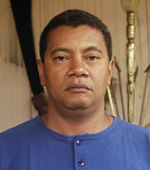 |
Wuelyton Alvarenga dos Santos was born in Rio de Janeiro in 1965 and his fate seems to have been written in iron and fire by powerful orishas. “I went to a technical school and learned how to work with naval machinery, and despite not being in the navy I worked for their arsenal department. Working with metal has always been easy for me. I learned the basics at school and then it was all down to practice. I developed a technique of forging iron and other metals, and it came to me as a gift” – explains Wuelyton Ferreiro (blacksmith) as he became known. His pieces deserve the same respect as other liturgic art found in museums and galleries. They unite erudite and popular aspects of Western culture with African roots that go deep into Brazil’s cultural identity. “I believe in camdomblé, and I’ve been going to a religious house in São Gonçalo for the last 18 years. The babalorixá (afro brazilian priestess) needed a certain piece and didn’t know who could make it, so I made it for her. And now I make pieces in iron for camdomblé communities in Rio de Janeiro, São Paulo and Bahia.” His workshop is small, but enough for what he needs. It’s a place full of sacred energy. Iron, fire, air, water and earth seem to come together through the blacksmith’s hands as he heats, bends and cools the iron in a lonely ritual full of secrets. His pieces are unique, and void of the kind of commercial apppeal that tends to make things equal and bland. His work exists within the ancient traditions of African myths, and seems to follow instructions given by the orishas.
Wuelyton Ferreiro is part of the camdomblé community Ilê Axé Oju Obá Ogô Odô, in Belfort Roxo (RJ) and has exhibited his work in iron at the Master Vitalino Gallery at the Edson Carneiro Folklore Museum, in Rio de Janeiro. In the catalog for that exhibition Roberto Conduru, curator and professor of the Arts Institute of the State University of Rio de Janeiro, said that Wuelyton Ferreiro’s pieces had a symbolic meaning: “a lot of it is evident, but nothing is explicit. Apart from having ones eyes and ears open, one must have all the senses awake and the will to, humbly, learn how to read again. Like the blacksmith, viewers must have patience, as well as expertise and cleverness to hunt for the meaning of shapes, and how time and space lead to artistic fulfilment and, most importantly, the union with the forces of nature”. |


